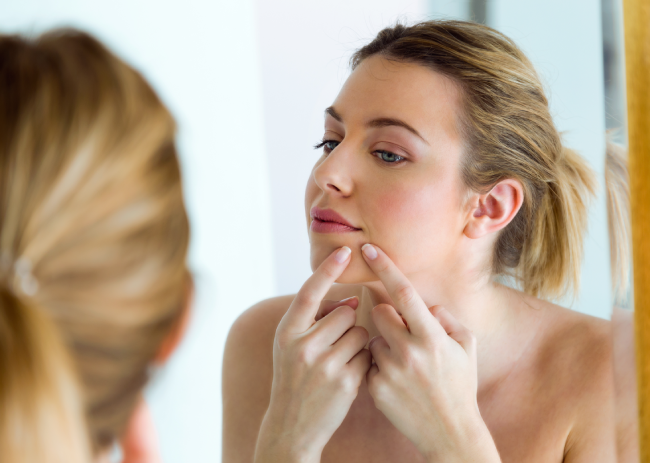Your skin is the largest organ that covers your body and serves many functions, such as keeping out bacteria, allowing you to feel sensations, and stabilising your body temperature. Skin issues are one of the most common reasons why people see their doctor. Whether you experience itching, flaking, or spots, there are different skin conditions you need to know about. They may involve clogging, irritating or inflaming your skin. In many cases, skin diseases cause rashes and a range of other changes in your appearance. To help you identify common skin conditions and find treatment, we have prepared a detailed guide, which will help you get a better understanding of what to look out for.
#1. Ringworm
Ringworm is a common skin condition, which can cause a ring-shaped rash that is often itchy and red. This is a contagious fungal infection, that can be found on the skin, as well as surfaces and items, such as towels, clothes, and bedding. The main symptoms you can experience include a rash, that looks red, silver, or darker than the surrounding skin, depending on your skin tone. It can develop on different parts of the body, including the scalp. Once diagnosed, ringworm is treated with topical antifungal creams and ointments available over the counter or with a prescription.
#2. Atopic Eczema
Atopic eczema usually starts early in childhood, but it may also develop in adulthood. In terms of severity, it can range from mild to severe. You can learn more about this condition by checking out this guide on atopic eczema. Patient offers a comprehensive directory of evidence-based clinical information, that is designed to help you take charge of your health. The information is provided by a range of trained medical professionals, following a strict peer-review process. It allows you to familiarise yourself with the symptoms of atopic eczema, the possible causes, treatment options, and prevention techniques.
#3. Acne
Acne is a common skin condition, that many people experience at some point or another throughout their lives. It is often caused by blocked oil glands and hair follicles of the skin, which are often triggered due to hormonal changes. If you have acne, you may notice spots, oily skin, and at times skin that is hot or too painful to touch. In most cases, it develops on the face, back, and chest. There are different types of spots, you may experience, including cysts, nodules, blackheads, pustules, whiteheads and papules. You can try washing the affected area with mild soap or cleanser and lukewarm water and avoid using too much make-up and cosmetics.
#4. Cellulitis
Cellulitis may begin as a superficial skin infection, sometimes due to a tiny break in the skin, which allows bacteria. However, it can become more serious if bacteria enter the bloodstream. It can also be triggered if bacteria enter broken skin, caused by eczema. Typically, cellulitis occurs as an area of skin becomes red, warm, and tender. This typically occurs on the legs or feet and may also cause a fever and chills. Mild cases affecting a small area of skin can be treated with oral antibiotics, while serious cases may require emergency medical care.
#5. Contact Dermatitis
It is a type of eczema, which presents itself as a red and itchy rash triggered by an allergic reaction or direct contact with a substance. While this skin condition isn’t contagious or life-threatening, it can be irritating and uncomfortable. There are many substances, that cause this reaction, including cosmetics, soaps, fragrances, jewellery, and plants. It may also be accompanied by blistering or burning, and in some cases, it can make it difficult to sleep and concentrate during the day. The rash from contact dermatitis can be improved using topical creams or systemic medication.
#6. Rosacea
Rosacea is a long-term skin condition, that typically appears on the face. In most cases, it affects people with lighter skin and women, but symptoms may be worse in men. Some of the most common causes include problems with the immune system, vein problems, or environmental issues. The first signs of rosacea are redness across the cheeks, nose, chin and forehead which comes and goes. It may also involve a stinging or burning sensation when using water or certain skincare products. There are several effective ways to combat rosacea. However, it is also advisable to see your GP for further guidance.
#7. Hives
Hives, also called urticaria, are an itchy and raised rash, triggered by a reaction to things, such as pollen, food, or insect bites. This condition may occur in different sizes and shapes and it can be found anywhere on the body in both adults and children. Although most people with hives don’t feel ill, the appearance of the rash can be concerning and troublesome. It is important to determine if there is a specific cause or trigger, so keeping a symptom diary may be helpful. A pharmacist can help you find a suitable treatment option, which usually involves antihistamine tablets.
#8. Athlete’s Foot
Your feet are prone to fungal infections, such as athlete’s foot, which presents itself in itchy, white patches between your toes. Additionally, it may cause sore and flaky patches on your feet. The skin may appear red, but this may not be as noticeable on brown or black skin. It is also possible that the skin on your feet can become cracked and bleed. If left untreated, the infection can spread to your toenails and result in a fungal nail infection. Effective treatments include sprays, creams, and powders from a pharmacy. You may need to try a few different methods to find out which works best.
#9. Warts
Warts are caused by the human papillomavirus (HPV) and consist of small lumps on the skin. Most people will experience them at one point or another in their lives. Although they usually go away on their own, sometimes this may take months or even years. They can be treated at home or by a medical professional. For example, many warts respond well to treatments and patches containing salicylic acid. To prevent warts from spreading to other parts of your body, it is recommended to cover them with a bandage, wash your hands regularly, and keep your hands and feet dry.
#10. Sunburn
Sunburn is an inflammatory reaction, which occurs when there is too much exposure to ultraviolet (UV) light from the sun or sunlamps. The skin turns red, sore, hot to the touch, and even peels away after a few days. Repeated sunburns can be dangerous, especially to children, as they increase the chance of developing skin cancer later in life. Remember that sunscreen needs to be reapplied every 2 hours and it is important to stay out of the sun during the hottest times of the day. To treat sunburn, you can take a cool bath, drink plenty of liquids, and moisturise the skin.
#11. Cold Sore
Cold sores are small, fluid-filled blisters that can appear anywhere on the face, especially on and around the lips. They are a common viral infection, which can make the affected skin feel painful or delicate. Before the blisters occur, you may experience itchiness or a burning sensation. Once the blisters break, a scab begins to form, which usually lasts several stromectol for sale days. Typically, cold sores heal within two to three weeks without leaving any scars. Although there is no treatment for cold sores, there are some effective treatment options that can manage outbreaks and speed up the healing process. If you regularly get cold sores, a pharmacist can recommend creams and cold sore patches to ease pain and irritation.

